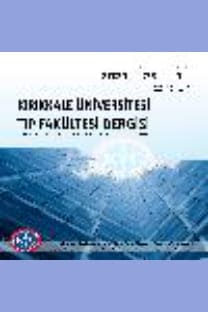SPİNAL ANESTEZİDE PREHİDRASYON SEREBRAL OKSİJENASYONU ETKİLER Mİ?
Serebral oksijenasyon, spinal anestezi, prehidrasyon
Does Prehydration in Spinal Anaesthesia Affect Oxygenation?
Cerebral oxygenation, spinal anesthesia, prehydration,
___
- 1. Andrews WW, Ramin SM, Maberry MC, Shearer V, Black S, Wallace DH. Effect of type of anesthesia on blood loss at elective repeat cesarean section. Am J Perinatol. 1992;9(3):197-200. Doi:10.1055/s-2007-999320.
- 2. Urwin SC, Parker MJ, Griffiths R. General versus regional anaesthesia for hip fracture surgery: a meta-analysis of randomized trials. Br J Anaesth. 2000;84(4):450-5.
- 3. Ceruti S, Anselmi L, Minotti B, Franceschini D, Aguirre J, Borgeat A et al. Prevention of arterial hypotension after spinal anaesthesia using vena cava ultrasound to guide fluid management. Br J Anaesth. 2018;120(1):101-8. Doi: 10.1016/j.bja.2017.08.001.
- 4. Cuvas O, Er AE, Ongen E, Basar H. Spinal anesthesia for transurethral resection operations. Bupivacaine versus levobupivacaine. MinervaAnestesiol. 2008;74(12):697-701.
- 5. Ni HF, Liu HY, Zhang J, Peng K, Ji FH. Crystalloid coload reduced the incidence of hypotension in spinal anesthesia forces are andelivery, when compared to crystalloid preload: A Meta-Analysis. Biomed Res Int. 2017;3462529. Doi:10.1155/2017/3462529 (Epub 2017 Dec 17).
- 6. Tawfik MM, Tarbay AI, Elaidy AM, Awad KA, Ezz HM, Tolba MA. Combined colloid preload and crystalloid coload versus crystalloid coload during spinal anesthesia forces are andelivery: a randomized controlled trial. Anesth Analg. 2019;128(2):304-312 Doi:10.1213/ANE.0000000000003306.
- 7. Practice guidelines for obstetric anesthesia: an updated report by the american society of anesthesiologists task force on obstetric anesthesia and the society for obstetric anesthesia and perinatology. Anesthesiology. 2016;124(2):270-300. Doi:10.1097/ALN.0000000000000935.
- 8. Hahn RG. Volume kinetics for infusion fluids. Anesthesiology. 2010;113(2):470-81. Doi:10.1097/ALN.0b013e3181dcd88f.
- 9. Westphal M, James MF, Kozek-Langenecker S, Stocker R, Guidet B, Van Aken H. Hydroxyethyl starches: different products–different effects. Anesthesiology. 2009;111(1):187-202. Doi:10.1097/ALN.0b013e3181a7ec82.
- 10. Saghafinia M, Jalali A, Eskandari M, Eskandari N, Lak M. TheEffects of hydroxyethylstarch 6% and crystalloid on volume preloading changes following spinal anesthesia. Adv Biomed Res. 2017;21;6:115. Doi:10.4103/abr.abr_151_16. eCollection 2017.
- 11. Bottiger BA, Bezinover DS, MetsB, Dalal PG, Prozesky J, Ural S et al. Phenylephrine infusion for spinal-induced hypotension in elective cesarean delivery: Does preload make a difference? J Anaesthesiol Clin Pharmacol. 2016;32(3):319-24. Doi:10.4103/0970-9185.168159.
- 12. Sun S, Liu NH, Huang SQ. Role of cerebral oxygenation for prediction of hypotension after spinal anesthesia for caesarean section. J Clin Monit Comput. 2016;30(4):417-21. Doi:10.1007/s10877-015-9733-4 (Epub 2015 Jul 18).
- 13. Çelik EC, Çiftçi B. Serebral oksimetre ve anestezi altında uygulama alanları. İst Tıp Fak Derg. 2018;81(1):33-6.
- 14. Madsen PL, Secher NH. Near-infrared oximetry of the brain. Prog Neurobiol. 1999;58(6):541-60.
- 15. Denault A, Deschamps A, Murkin JM. A proposed algorithm for the intraoperative use of cerebral near-infrared spectroscopy. Semin Cardiothorac Vasc Anesth. 2007;11(4):274-81. Doi:10.1177/1089253207311685.
- 16. Akçay L, Soyalp C, Yüzkat N, Gülhaş N. A comparison of the effects of desflurane and sevoflurane on cerebral oxygen saturation in patients undergoing thyroidectomy: a randomized controlled clinical study. Turk J Anaesthesiol Reanim. 2019; Doi:10.5152/TJAR.2019.23911.
- ISSN: 2148-9645
- Yayın Aralığı: 3
- Başlangıç: 1999
- Yayıncı: KIRIKKALE ÜNİVERSİTESİ KÜTÜPHANE VE DOKÜMANTASYON BAŞKANLIĞI
BÖBREK TÜMÖRÜ VAKALARININ RETROSPEKTİF OLARAK DEĞERLENDİRİLMESİ
Nesrin GÖKÇINAR, Yaprak AKBULUT, Tevfik OĞUREL, Salih KOÇ, Zafer ONARAN
Koroner Arter Hastalığı ile Myokardiyal Köprüleşme Arasındaki İlişki
Hasanali DURMAZ, Onur ERGUN, Kürşat GÜREŞCİ, Erdem BİRGİ, Azad HEKİMOĞLU, BAKİ HEKİMOĞLU
SAĞLIK BİLİMLERİ FAKÜLTESİ SON SINIF ÖĞRENCİLERİNDE ÖFKE DURUMU
SERPİL ÇELİK DURMUŞ, Yurdagül ERDEM, Mesut GÖKÇEN
Nermin DİNDAR BADEM, Seydi Ali PEKER, Sedat KAYGUSUZ
UYANIK FİBEROPTİK ENTÜBASYON: BEKLENEN ZOR HAVA YOLU
Gülçin AYDIN, Ayşe Gizem SARAÇOĞLU, Ahmet Tuğrul ŞAHİN, Murat ALPARSLAN, Seydi GÜNDOĞAN, Yahya Fatih KOÇAK, Ela CÖMERT
